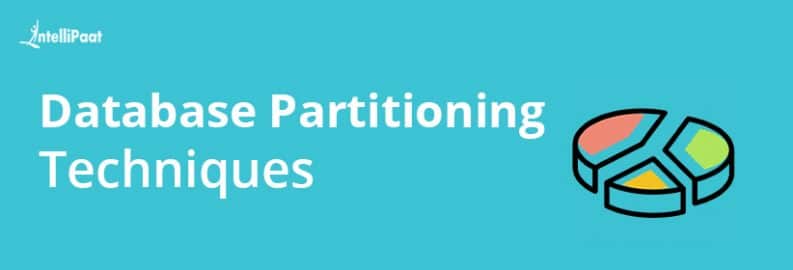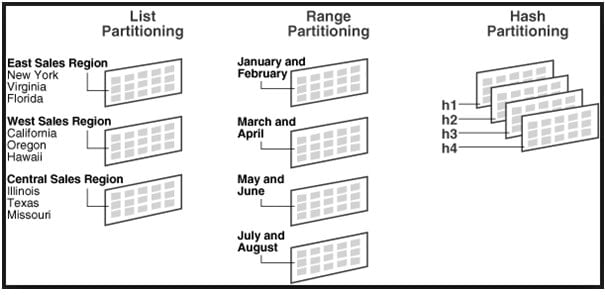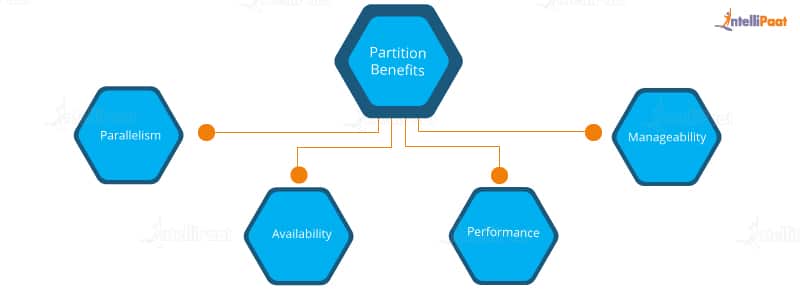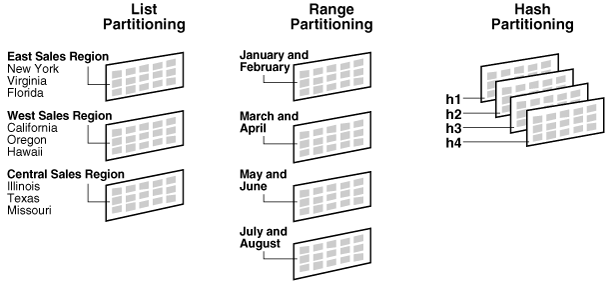Database Partitioning Techniques
Since you ask for a simple demonstration - assume you have a table like this. Oracle provides a comprehensive range of partitioning schemes to address every business requirement.

Database Partitioning Techniques Intellipaat Blog
Basically there are two methods or types of partitioning in datastage.

Database partitioning techniques. After that just pick round robin for the next partitioning point and pass through for each subsequent one. Partitioning provides a technique to subdivide objects into smaller pieces. Database Partitioning ikhan May 19 2011 112 PM in response to user180566 you can fool the Source Qualifier at the session level thereby allowing all data coming through only one partition.
The most efficient queries retrieve data by specifying the partition key and the row key. Each partition has its own name. Near-uniform range Partitioning Algorithm NPA 7 is used as increased partitioning approach.
Database partitioning is normally done for manageability performance or availability reasons or for load balancing. Table partitioning helps in significantly improving database server performance as less number of rows have to be read processed and returned. Partitioning allows a table index or index-organized table to be subdivided into smaller pieces where each piece of such a database object is called a partition.
Below partition techniques which can be implemented in parallel stages explained with the examples. Choose a partition keyrow key combination that supports the majority of your queries. Partitioning is powerful functionality that allows tables indexes and index-organized tables to be subdivided into smaller pieces enabling these database objects to be managed and accessed at a finer level of granularity.
What is a database table partitioning. Partitioning allows each partition to be deployed on a different type of data store based on cost and the built-in features that data store offers. The first technique functional decomposition puts different databases on different servers.
We have already discussed about different data-partitioning techniques namely Round-robin Hash and Range Partitioning in an older post. The above said data-partitioning strategies are useful in partitioning data across several processors to establish a complete. Partitioning the tablesdatabases is very important step in parallelizing the database activities.
Vertical partitioning aka row splitting uses the same splitting techniques as database normalization but ususally the term vertical horizontal data partitioning refers to a physical optimization whereas normalization is an optimization on the conceptual level. Partitioning is the database process where very large tables are divided into multiple smaller parts. By splitting a large table into smaller individual tables queries that access only a fraction of the data can run faster because there is less data to scan.
Select a partition key and row key by how the data is accessed. Table partitioning can be of two types namely vertical partitioning or horizontal partitioning. Using this method we are going to split a table.
In this systems design video I will be going over how to scale databases using database partitioning in particular horizontal. A partition is a division of a logical database or its constituent elements into distinct independent parts. One of the most widely used partitioning techniques is partition pruning.
Database partitioning technique which adopts divide and conquer method can efficiently simplify the complexity of managing massive data and improve the performance of the system especially the. Duplicated rows are stored and the data volume is significantly. It is popular in distributed database management systems where each partition may be spread over multiple nodes with users at the node performing local transactions on the partition.
Sharding Database Partitioning System Design Basics - YouTube. NRUP is efficiently used for partitioning of large databases which leads into a good advantage of this method because this automates the partitioning of large database. Partitioning is a technique which allows tables indexes and index-organized tables to be subdivided into smaller pieces enabling these database objects to be managed and accessed at a finer.
By partitioning the data equally into many different processors workload we can achieve better performance better parallelism of the whole system. The second techniquevertical partitioningputs different columns of a table on different servers. Queries that specify a partition key and a range of row keys can be completed by scanning a single partition.
We can use partitioning techniques for dividing indexes and index-organized tables also. Partitioning is a physical database design technique that many data modelers and DBAs are quite familiar with. As the names suggest we can guess that partitioning is based on the key column whichever you defined.
With partition pruning the database optimizer looks at the query statement and eliminates unwanted partitions in building the partition access list. All rows from a dataset are distributed to each partition. For example large binary data can be stored in blob storage while more structured data can be held in a document database.
We have the following types of fragmentation partitioning techniques in Parallel database. Data partitioning is a technique for physically dividing the data during the loading of the Master Data. Comparison of different data-partitioning strategies based on the data-access types.
Although partitioning can be used to accomplish a number of various objectives the main goal is to reduce the amount of data read for particular SQL operations so. The third techniqueshardingis similar to horizontal partitioning in databases in that different rows are put in different database servers. Less frequent used partitioning method Every node receives the complete set of input data ie form the above example all the records are sent to all four nodesWe mostly use this partitioning method with stages that create lookup tables from their input.

Database Partitioning Techniques Intellipaat Blog

Database Partitioning Techniques Intellipaat Blog

Posting Komentar untuk "Database Partitioning Techniques"